MPPN ransomware virus attacks unprotected computers to encrypt all data in them
Contents
The recent release of MPPN ransomware virus has become a threat to all computer users. Those circulating it intend to infect as many devices as possible; these rogues that go by STOP/DJVU usually use diverse deceptive methods to take their victims unawares. Once they succeed in that, it will commence data encryption whereby all files contained in the computer will be encrypted simultaneously. Just as the name suggests, the motive is to use the encrypted files as hostages and try to extort money from the victims. Due to the destructive nature of MPPN ransomware virus, it is best for computer owners to take proactive steps against it. This article comes in handy guide to help you secure your computer and the files contained in it.
Certain series of activities usually take place once cybercriminals succeed in infecting any computer. First is the commencement of the encryption process. Files stored in the infected computer would automatically become unreadable. Such files may include MS Word documents, pictures, videos, PDFs, etc. Afterward, .mppn extension would be appended to each file name. What it means is that files saved as 1.png, 2.jpg, or 3.jpeg automatically transform to 1.png.mppn, 2.jpg.mppn and 3.jpeg.mppn respectively. What happens next is the creation of the ransom note. It is all about letting the victim know about the situation. This is done through short messages (known as _readme.txt) dropped in all the affected folders.

Ransom note contents
Also contained in the _readme.txt notifications are two emails e.g. support@fishmail.top and datarestorehelp@airmail.cc. The idea is for the victim to reach out to them for possible assistance in recovering their encrypted files. But when victims decide to seek their help, they typically respond by demanding a ransom fee of $980 as a prerequisite.
Other conditions may include a promise to slash the ransom fee by half if the victim can pay within 72 hours of being asked to do so. The ransom fee slash becomes nullified once the 3 days payment window elapses, meaning only the maximum fee will be accepted. It doesn’t end there; they also insist that payment must be made with the use of cryptocurrency. In other words, the victim must buy cryptocurrency that is worth the ransom fee and equally send it to a wallet address that will be provided by the cybercriminals. It should be noted that cybercriminals prefer such anonymous methods of payment because they don’t want to be tracked down and apprehended.
It is not worth it to go through all these troubles based on previous experiences as narrated by victims. When cybercriminals receive ransom from their victims, they usually disappear into thin air or forward fake decryption tools that won’t work. Also, there are other reasons why victims of a ransomware attack should never pay a ransom.

We came up with this advice after considering the effects of paying a ransom. It is also necessary to emphasize that our stand on this issue is in tandem with the recommendations the FBI and other reputable cybersecurity organizations put forward.
Some of the reasons why paying ransom is discouraged include the following:
- It is generally against the law in many countries.
- Ransom payment encourages cybercriminals to continue their illegal activities.
- More funds in the hands of cybercriminals make it easy for them to expand their operations.
- Victims that pay ransom make themselves prone to further attacks in the future.
- Ransom payments make criminality profitable for cybercriminals.
If you have been affected by this computer virus, we recommend you to remove MPPN ransomware without a delay. You can follow the instructions below the article to learn how to start your computer in Safe Mode with Networking. Then, we recommend that you use a trustworthy antivirus, such as INTEGO Antivirus to remove the malware. Afterward, you may want to try RESTORO (secure download link), which is a great tool for repairing virus damage on Windows OS files.
Ransomware Summary
| Name | MPPN Ransomware Virus |
| Type | Ransomware; Crypto-malware; Virtual Extortion Virus |
| Family | STOP/DJVU |
| Encryption type | RSA 2048 + Salsa20 |
| Previous versions | KAAA, BGJS, BGZQ (find full list here) |
| Version | 612th |
| Extension | .mppn |
| Cybercriminal emails | support@fishmail.top and datarestorehelp@airmail.cc |
| Additional malware dropped | Azorult or Vidar Trojan |
| Damage | The ransomware uses encryption to maliciously modify all files on the PC and marks their original names with .mppn extension. Ransom notes called as _readme.txt will be dropped in every computer folder. This piece of malware usually drags VIDAR Stealer alongside it and also eliminates VSS from the system. On top of that, it tends to modify Windows HOSTS file to restrict computer user’s access to cybersecurity-related websites online. |
| Ransom note | _readme.txt |
| Ransom demand | $490-$980 in Bitcoin |
| Distribution | Victims often download this ransomware along illegal torrent downloads, cracked software, activators, key generators or tools like KMSPico. |
| Known software cracks to contain this malware | Corel Draw, Tenorshare 4ukey, Adobe Photoshop, Cubase, Adobe Illustrator, Internet Download Manager, Tally, League of Legends. |
| Detection names | Trojan:Win32/Azorult.FW!MTB (Microsoft), Gen:Heur.Mint.Zard.52 (B) (Emsisoft), HEUR:Trojan.Win32.Scarsi.gen (Kaspersky), Gen:Heur.Mint.Zard.52 (BitDefender), Trojan.MalPack.GS (Malwarebytes), ML.Attribute.HighConfidence (Symantec) see all detection name variations on VirusTotal |
| Removal | Remove ransomware and related malware from your PC using trustworthy software like INTEGO Antivirus. To repair virus damage on Windows OS files, download and try RESTORO (secure download link). |

Intego Antivirus for Windows
Award-winning antivirus solution for your PC.
Robust security software that provides robust 24/7 real-time protection, Web Shield that stops online threats/malicious downloads, and Prevention engine that wards off Zero-Day threats. Keep your PC safe and protected against ransomware, Trojans, viruses, spyware and other forms of dangerous programs.

Major ways used by cybercriminals in distributing ransomware virus
Almost every computer user understands the need to protect their PCs against all forms of malware. However, many still fail to do the right thing, thereby falling victim to cybercriminals. Although there are different methods used by cybercriminals in spreading ransomware viruses, we will point out the three most common ones.
P2P Sharing Networks and Online Torrent Sites
Cybercriminals promote the circulation of cloned software content via peer-to-peer sharing networks. They understand that some software users don’t like paying the fees demanded by the brand owners. So what they do is to pirate those in high demand, embed them with malware and aid their distribution via P2P. Those using P2P are only putting their computer at serious risk of malware infection. Instead of getting involved in such risky activities, software content should be paid for and downloaded using officially recognized platforms.
Using online torrent sites to spread malware is another option used by cybercriminals. This method is similar to P2P because cloned software content is illegally uploaded for mass downloads on rogue websites, and then can be downloaded via P2P sharing software.
Cybercriminals often make it appear like a cheap alternative but remember they’re not doing it to help others but to spread the virus. To avoid becoming a victim, you should never make use of online torrent platforms. It’s better to pay the official price for any software and safely download it to your computer.
We have compiled a list of popular software copies cybercriminals often pirate and use to spread ransomware viruses. They are in no particular order:
- VMware Workstation;
- HP Printer Drivers;
- Cubase;
- Adobe Photoshop;
- Adobe Illustrator;
- Internet Download Manager;
- League of Legends;
- Microsoft Office;
- FIFA 22;
- Corel Draw;
- Tenorshare 4ukey.
Use of Fake Emails & Attachments
Another method of spreading malware is through fake emails and attachments. In this case, cybercriminals deceptively claim to be who they are not. They may impersonate popular brands like Amazon, eBay, or DHL, etc., and also use business terms like Order Summary, Waybill, Parcel Tracking Details, or Invoice to name the malicious email attachments. They will forward the fake emails and attachments to random emails. They usually purchase such email lists on dark web forums that often publish various information leaks for free or ask for payment to access it. Such emails and attachments should never be opened but rather deleted instantly.
Sometimes, cybercriminals may also attach remote access Trojans to the primary virus. RATs are used by these rogues to steal important personal information such as credit card details, banking information, software login information, etc. They can even hide in any computer for a long time if the computer does not have genuine antivirus installed.
To sum up, there are other dos and don’ts that should be complied with to ensure the safety of any computer. One of such is to avoid the use of pirated or cloned versions of software copies. Cybercriminals can be cunning, so they select popular software copies, clone and embed them with malware before circulating them.
Unsuspecting end users may consider such cloned variants as a cheap alternative to genuine ones. However, we have concluded that such an assumption is false. It is much better to pay the price requested by the copyright owners and be safe instead of using the cloned versions. Using cloned versions can result in loss of important files and man hours, as well as disruption of work or even loss of money.
Finally, users should be extremely careful and inspect the sources they choose to download software from. Trusting suspicious websites that promise premium software for free is a bad idea.
MPPN Ransomware Virus Removal
We advise that victims remove MPPN ransomware virus ASAP. The reliable way of getting rid of it is by using any genuine antivirus software. However, INTEGO Antivirus has proven to be very effective.
Other vital steps that should be taken after MPPN ransomware removal include the following:
- Changing all passwords that were previously used in the compromised computer.
- Restoration of lost files using a backup device.
- If necessary, you should consider informing relevant local authorities about the situation.
- Download INTEGO Antivirus to see what files can be repaired after the ransomware attack.
OUR GEEKS RECOMMEND
Our team recommends removing malware using a professional antivirus software.
REMOVE THREATS WITH ROBUST ANTIVIRUS

Get INTEGO ANTIVIRUS for Windows to remove ransomware, Trojans, adware and other spyware and malware variants and protect your PC and network drives 24/7. This VB100-certified security software uses state-of-art technology to provide protection against ransomware, Zero-Day attacks and advanced threats, Intego Web Shield blocks dangerous websites, phishing attacks, malicious downloads and installation of potentially unwanted programs.
Use INTEGO Antivirus to remove detected threats from your computer.
GeeksAdvice.com editors select recommended products based on their effectiveness. We may earn a commission from affiliate links, at no additional cost to you. Learn more.
MPPN Ransomware Virus Removal Guidelines
Method 1. Enter Safe Mode with Networking
Step 1. Start Windows in Safe Mode with Networking
Before you try to remove MPPN Ransomware Virus virus, you must start your computer in Safe Mode with Networking. Below, we provide the easiest ways to boot PC in the said mode, but you can find additional ones in this in-depth tutorial on our website – How to Start Windows in Safe Mode. Also, if you prefer a video version of the tutorial, check our guide How to Start Windows in Safe Mode on Youtube.
Instructions for Windows XP/Vista/7 users
- First of all, turn off your PC. Then press the Power button to start it again and instantly start pressing F8 button on your keyboard repeatedly in 1-second intervals. This launches the Advanced Boot Options menu.
- Use arrow keys on the keyboard to navigate down to Safe Mode with Networking option and press Enter.

Instructions for Windows 8/8.1/10/11 users
- Open Windows Start menu, then press down the Power button. On your keyboard, press down and hold the Shift key, and then select Restart option.

- This will take you to Windows Troubleshoot screen. Choose Troubleshoot > Advanced Options > Startup Settings > Restart. Tip: If you can't find Startup Settings, click See more recovery options.

- In Startup Settings, press the right key between F1-F9 to enter Safe Mode with Networking. In this case, it is the F5 key.

Step 2. Remove files associated with the virus
Now, you can search for and remove MPPN Ransomware Virus files. It is very hard to identify files and registry keys that belong to the ransomware virus, Besides, malware creators tend to rename and change them repeatedly. Therefore, the easiest way to uninstall such type of a computer virus is to use a reliable security program such as INTEGO Antivirus. For virus damage repair, consider using RESTORO.
Special Offer
Compatibility: Microsoft Windows
See Full Review
RESTORO is a unique PC Repair Tool which comes with an in-built Avira scan engine to detect and remove spyware/malware threats and uses a patented technology to repair virus damage. The software can repair damaged, missing or malfunctioning Windows OS files, corrupted DLLs, and more. The free version offers a scan that detects issues. To fix them, license key for the full software version must be purchased.
Method 2. Use System Restore
In order to use System Restore, you must have a system restore point, created either manually or automatically.
Step 1. Boot Windows in Safe Mode with Command Prompt
Instructions for Windows XP/Vista/7 users
- Shut down your PC. Start it again by pressing the Power button and instantly start pressing F8 button on your keyboard repeatedly in 1-second intervals. You will see Advanced Boot Options menu.
- Using arrow keys on the keyboard, navigate down to Safe Mode with Command Prompt option and press Enter.

Instructions for Windows 8/8.1/10/11 users
- Launch Windows Start menu, then click the Power button. On your keyboard, press down and hold the Shift key, and then choose Restart option with the mouse cursor.

- This will take you to Windows Troubleshoot screen. Choose Troubleshoot > Advanced Options > Startup Settings > Restart. Tip: If you can't find Startup Settings, click See more recovery options.

- In Startup Settings, press the right key between F1-F9 to enter Safe Mode with Command Prompt. In this case, press F6 key.

Step 2. Start System Restore process
- Wait until system loads and command prompt shows up.
- Type cd restore and press Enter, then type rstrui.exe and press Enter. Or you can just type %systemroot%system32restorerstrui.exe in command prompt and hit Enter.

- This launches System Restore window. Click Next and then choose a System Restore point created in the past. Choose one that was created before ransomware infection.

- Click Yes to begin the system restoration process.
After restoring the system, we recommend scanning the system with antivirus or anti-malware software. In most cases, there won't be any malware remains, but it never hurts to double-check. In addition, we highly recommend checking ransomware prevention guidelines provided by our experts in order to protect your PC against similar viruses in the future.
Alternative software recommendations
Malwarebytes Anti-Malware
Removing spyware and malware is one step towards cybersecurity. To protect yourself against ever-evolving threats, we strongly recommend purchasing a Premium version of Malwarebytes Anti-Malware, which provides security based on artificial intelligence and machine learning. Includes ransomware protection. See pricing options and protect yourself now.

System Mechanic Ultimate Defense
If you're looking for an all-in-one system maintenance suite that has 7 core components providing powerful real-time protection, on-demand malware removal, system optimization, data recovery, password manager, online privacy protection and secure driver wiping technology. Therefore, due to its wide-range of capabilities, System Mechanic Ultimate Defense deserves Geek's Advice approval. Get it now for 50% off. You may also be interested in its full review.

Disclaimer. This site includes affiliate links. We may earn a small commission by recommending certain products, at no additional cost for you. We only choose quality software and services to recommend.
Decrypt MPPN files
Fix and open large MPPN files easily:
It is reported that STOP/DJVU ransomware versions encrypt only the beginning 150 KB of each file to ensure that the virus manages to affect all files on the system. In some cases, the malicious program might skip some files at all. That said, we recommend testing this method on several big (>1GB) files first.
- Create a copy of encrypted file to a separate folder using Copy > Paste commands.
- Now, right-click the created copy and choose Rename. Select the MPPN extension and delete it. Press Enter to save changes.
- In the prompt asking whether you want to make the changes as file might become unusable, click OK.
- Try opening the file.
STOP/DJVU decryption tool usage guide
STOP/DJVU ransomware versions are grouped into old and new variants. MPPN Ransomware Virus is considered the new STOP/DJVU variant, just like KAAA, BGJS, BGZQ (find full list here). This means full data decryption is now possible only if you have been affected by offline encryption key. To decrypt your files, you will have to download Emsisoft Decryptor for STOP DJVU, a tool created and maintained by a genius security researcher Michael Gillespie.
Note! Please do not spam the security researcher with questions whether he can recover your files encrypted with online key - it is not possible.
In order to test the tool and see if it can decrypt MPPN files, follow the given tutorial.
- Download the decryption tool from Emsisoft.
- Click the little arrow next to your download and choose Show in Folder.
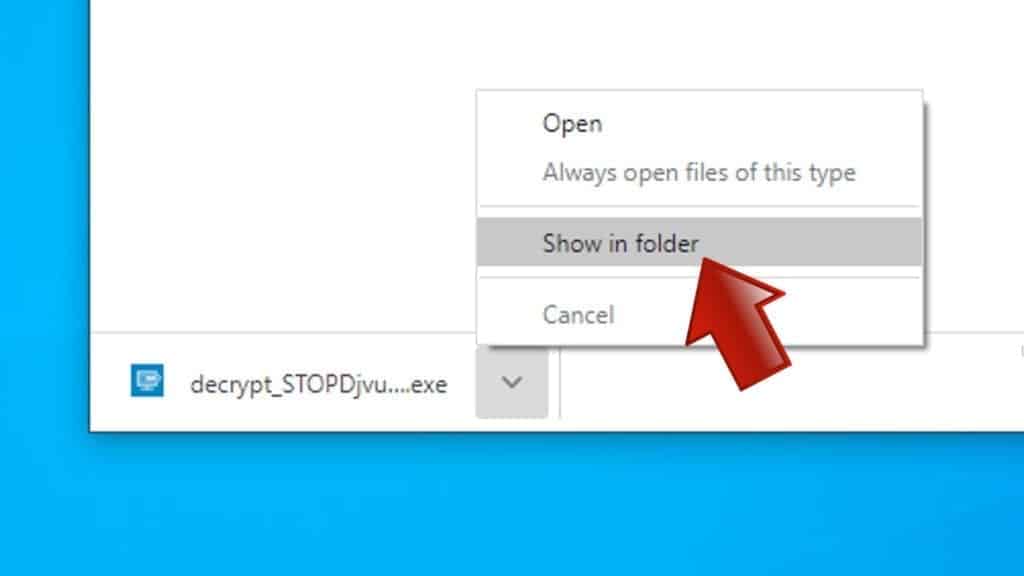
- Now, right-click the file and choose Run as Administrator. If asked, enter administrator's password.
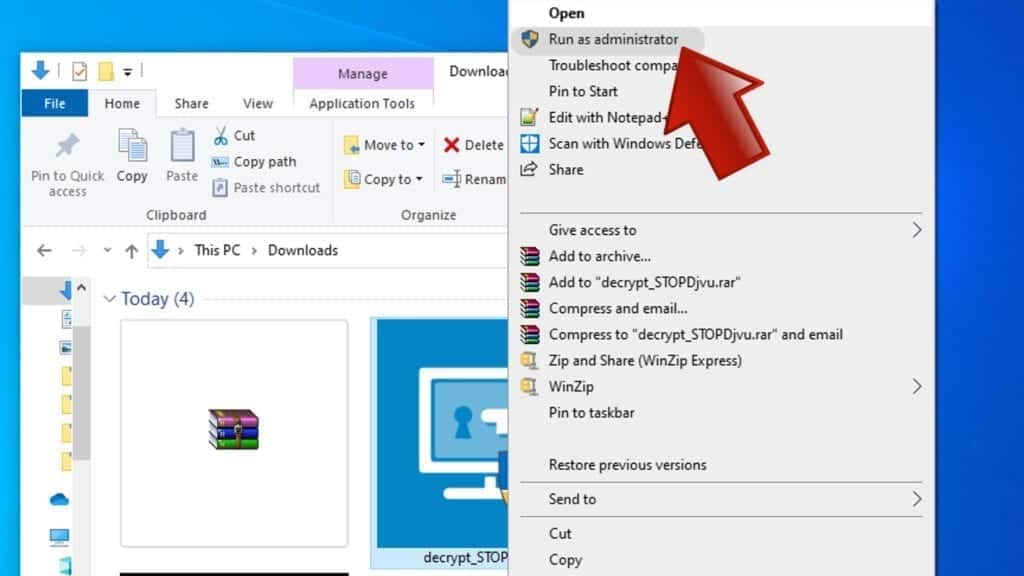
- In UAC window, click Yes.
- Click Yes to agree to software terms in both windows.
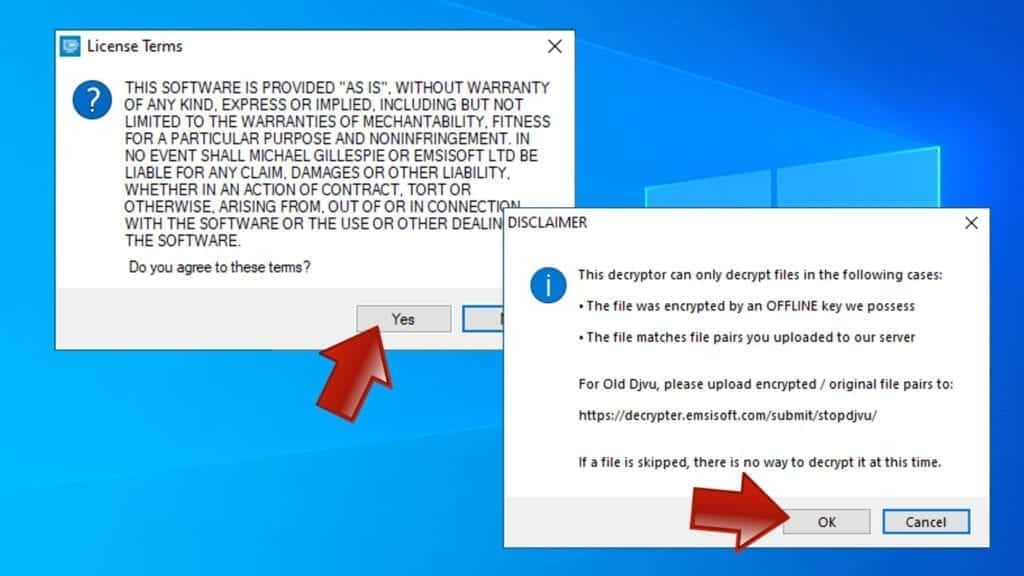
- The tool will automatically include C:// disk as a location to decrypt. The file recovery tool will prepopulate the locations to scan, including connected data storage drives or network drives. Click Add folder if you wish to add additional locations.
In Options tab, you can choose to keep encrypted file copies. We recommend leaving this option selected, especially if you do not know if the decryption tool will work.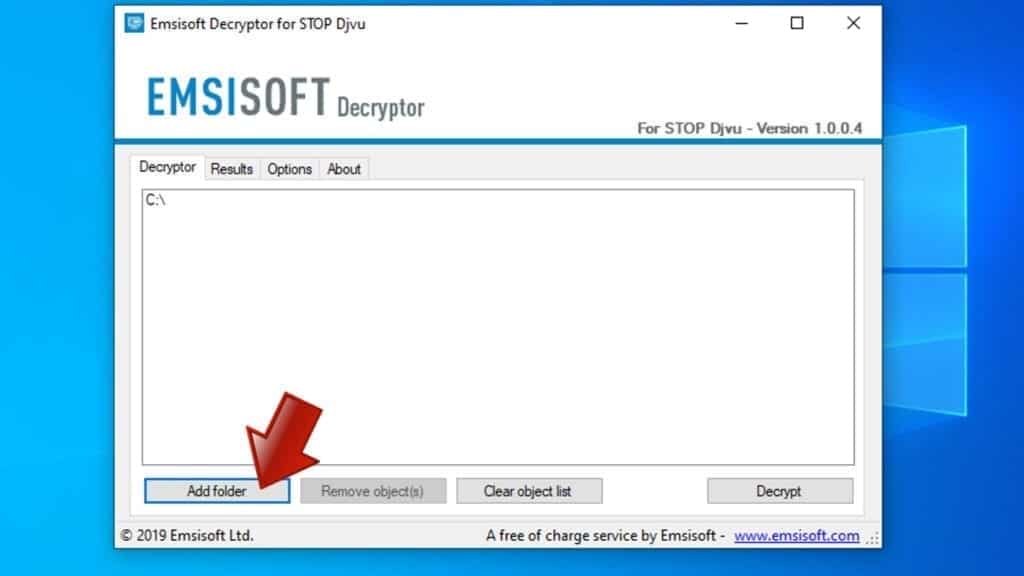
- Click Decrypt to start restoring MPPN files. You will see the progress in the Results tab. Here, you can see messages from the tool, such as whether the decryption procedure is successful, or you need to wait for an update.
You might also be informed that online key was used to encrypt your files. In such case, the decryption tool won't work for you, and the only way to recover your files is to use a data backup.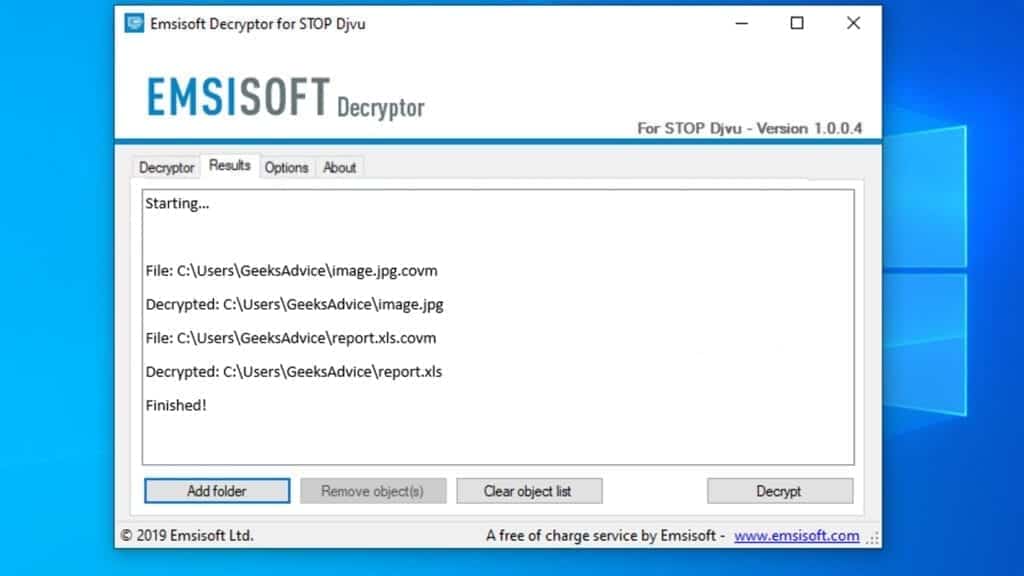
Meanings of decryptor's messages
The MPPN decryption tool might display several different messages after failed attempt to restore your files. You might receive one of the following messages:
Error: Unable to decrypt file with ID: [example ID]
This message typically means that there is no corresponding decryption key in the decryptor's database.
No key for New Variant online ID: [example ID]
Notice: this ID appears to be an online ID, decryption is impossible
This message informs that your files were encrypted with online key, meaning no one else has the same encryption/decryption key pair, therefore data recovery without paying the criminals is impossible.
Result: No key for new variant offline ID: [example ID]
This ID appears to be an offline ID. Decryption may be possible in the future.
If you were informed that an offline key was used, but files could not be restored, it means that the offline decryption key isn't available yet. However, receiving this message is extremely good news, meaning that it might be possible to restore your MPPN extension files in the future. It can take a few months until the decryption key gets found and uploaded to the decryptor. We recommend you to follow updates regarding the decryptable DJVU versions here. We strongly recommend backing up your encrypted data and waiting.
Report Internet crime to legal departments
Victims of MPPN Ransomware Virus should report the Internet crime incident to the official government fraud and scam website according to their country:
- In the United States, go to the On Guard Online website.
- In Australia, go to the SCAMwatch website.
- In Germany, go to the Bundesamt für Sicherheit in der Informationstechnik website.
- In Ireland, go to the An Garda Síochána website.
- In New Zealand, go to the Consumer Affairs Scams website.
- In the United Kingdom, go to the Action Fraud website.
- In Canada, go to the Canadian Anti-Fraud Centre.
- In India, go to Indian National Cybercrime Reporting Portal.
- In France, go to the Agence nationale de la sécurité des systèmes d’information.
If you can't find an authority corresponding to your location on this list, we recommend using any search engine to look up "[your country name] report cyber crime". This should lead you to the right authority website. We also recommend staying away from third-party crime report services that are often paid. It costs nothing to report Internet crime to official authorities.
Another recommendation is to contact your country's or region’s federal police or communications authority.
Frequently Asked Questions
You can only open MPPN files if you have the decryption key, or if you were affected by offline encryption type.
To figure out whether you were affected by offline encryption, please go to C:/SystemID/PersonalID.txt and see if the string inside of it ends in t1. You can also try using Emsisoft Decryptor for STOP/DJVU.
Please follow the guidances provided by the official MPPN decryption tools and believe what they say. If they say it is impossible to decrypt, it really is so. There is no magic tool or human capable of decrypting your files hiding somewhere. Encryption is a technique created to be nearly impossible to decrypt without a special private key (held by the criminals).
We advise scanning with anti-virus, anti-malware, malware removal tools or software like RESTORO to eliminate virus damage on the system. If you do not trust using a single tool, try running one after another. However, we do not recommend keeping several security programs on a computer at once as they can interfere with each other's work.
Beware of fake MPPN decryption tools circulating around the web. Cyber criminals are uploading them to various shady websites, also might be promoting them via suspicious Youtube videos. These programs can infect your computer even more heavily (Trojans, miners, etc.). We suggest being extremely cautious around the web. If there will be an official STOP/DJVU decryption tool available, it will be widely discussed in public media.

Norbert Webb is the head of Geek’s Advice team. He is the chief editor of the website who controls the quality of content published. The man also loves reading cybersecurity news, testing new software and sharing his insights on them. Norbert says that following his passion for information technology was one of the best decisions he has ever made. “I don’t feel like working while I’m doing something I love.” However, the geek has other interests, such as snowboarding and traveling.
Leave a Reply